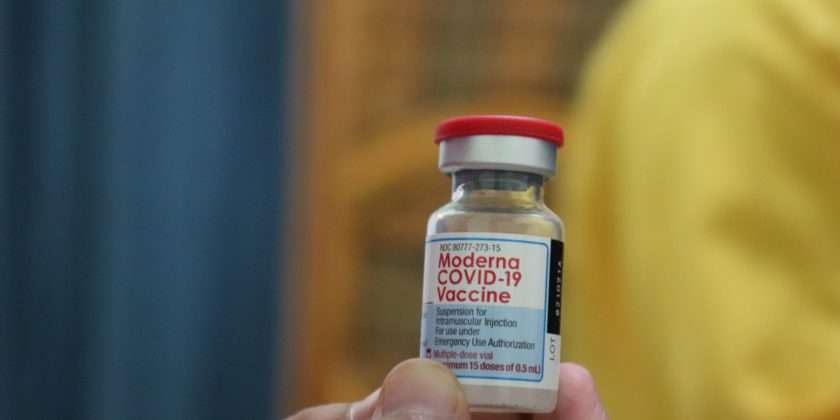“A people can prosper under a very bad government and suffer under a very good one if in the first case the local administration is effective and in the second it is inefficient.” – Annie Besant.
There are currently three vaccines for COVID-19 that are currently used in the United States. This post “COVID19 Vaccines Effectiveness: The Data,” will present the results of a study by the Centers for Disease Control & Prevention’s (CDC) September 24, 2021, MMWR report. The Morbidity and Mortality Weekly Report (MMWR) was posted online on Sept. 17, 20211.
Summary
What is already known about this topic?
Two 2-dose mRNA COVID-19 vaccines (from Pfizer-BioNTech and Moderna) and a 1-dose viral vector vaccine (from Janssen [Johnson & Johnson]) are currently used in the United States.
What is added by this report?
Among U.S. adults without immunocompromising conditions, vaccine effectiveness against COVID-19 hospitalization during March 11–August 15, 2021, was higher for the Moderna vaccine (93%) than the Pfizer-BioNTech vaccine (88%) and the Janssen vaccine (71%).
What are the implications for public health practice?
Although these real-world data suggest some variation in levels of protection by a vaccine, all FDA-approved or authorized COVID-19 vaccines provide substantial protection against COVID-19 hospitalization.
Discussion
Three COVID-19 vaccines are authorized or approved for use among adults in the United States (1,2). Two 2-dose mRNA vaccines, mRNA-1273 from Moderna and BNT162b2 from Pfizer-BioNTech, received Emergency Use Authorization (EUA) by the Food and Drug Administration (FDA) in December 2020 for persons aged ≥18 years and aged ≥16 years, respectively. A 1-dose viral vector vaccine (Ad26.COV2 from Janssen [Johnson & Johnson]) received EUA in February 2021 for persons aged ≥18 years (3). The Pfizer-BioNTech vaccine received FDA approval for persons aged ≥16 years on August 23, 2021 (4). Current guidelines from FDA and CDC recommend vaccination of eligible persons with one of these three products, without preference for any specific vaccine (4,5). To assess vaccine effectiveness (VE) of these three products in preventing COVID-19 hospitalization, CDC and collaborators conducted a case-control analysis among 3,689 adults aged ≥18 years who were hospitalized at 21 U.S. hospitals across 18 states from March 11–August 15, 2021. An additional analysis compared serum antibody levels (anti-spike immunoglobulin G [IgG] and anti–receptor-binding domain [RBD] IgG) to SARS-CoV-2, the virus that causes COVID-19, among 100 healthy volunteers enrolled at three hospitals 2–6 weeks after full vaccination with the Moderna,
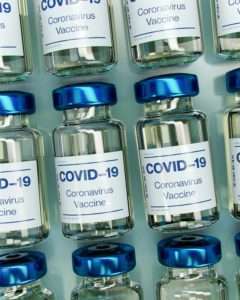
confidence interval [CI] = 91%–95%) than for the Pfizer-BioNTech vaccine (88%; 95% CI = 85%–91%) (p = 0.011); VE for both mRNA vaccines was higher than that for the Janssen vaccine (71%; 95% CI = 56%–81%) (all p<0.001). Protection for the Pfizer-BioNTech vaccine declined 4 months after vaccination. Postvaccination anti-spike IgG and anti-RBD IgG levels were significantly lower in persons vaccinated with the Janssen vaccine than the Moderna or Pfizer-BioNTech vaccines. Although these real-world data suggest some variation in levels of protection by a vaccine, all FDA-approved or authorized COVID-19 vaccines provide substantial protection against COVID-19 hospitalization.
For the VE analysis, adults aged ≥18 years without an immunocompromising condition admitted to 21 hospitals within the Influenza and Other Viruses in the Acutely Ill (IVY) Network were prospectively recruited for a case-control analysis (6,7). Case patients were admitted to a hospital with COVID-19–like illness† and a positive SARS-CoV-2 reverse transcription-polymerase chain reaction (RT-PCR) or antigen test result. Control patients were adults admitted to a hospital§ who received a negative SARS-CoV-2 RT-PCR test result.
Patients or their proxies were interviewed to obtain information about demographic characteristics, clinical history, and COVID-19 vaccination.¶ Information regarding vaccine products received by patients was collected by interview and source verification (e.g., state vaccination registries, hospital electronic medical records, and pharmacy records), including vaccine lot numbers, when
these were documented. A patient was considered fully vaccinated if the final vaccine dose (second dose for Moderna and Pfizer-BioNTech and the single Janssen dose) was received ≥14 days before illness onset.** Patients were excluded if they received a COVID-19 vaccine other than Moderna, Pfizer-BioNTech, or Janssen; received ≥1 vaccine dose but did not meet criteria for full vaccination; or received doses of two different COVID-19 vaccine products.
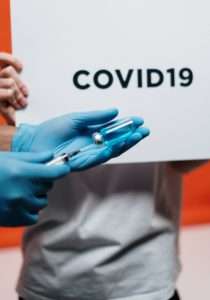
For the postvaccination antibody analysis, healthy adults aged ≥18 years with no known prior SARS-CoV-2 infection were recruited during April 6–June 4, 2021, at three IVY sites. Blood was collected 2–6 weeks after receipt of the second Moderna and Pfizer-BioNTech vaccine dose or the single Janssen vaccine dose. Sera were shipped to CDC, where they underwent testing for IgG
against three SARS-CoV-2 antigens: the spike protein (anti-spike); the spike RBD (anti-RBD); and nucleocapsid (anti-nucleocapsid). IgG levels were measured using the V-PLEX SARS-CoV-2 panel 2 kits (Meso Scale Diagnostics) and reported in international binding antibody units (BAU) per milliliter. Two participants with anti-nucleocapsid antibodies (>11.8 BAU), which is suggestive of a prior SARS-CoV-2
infection were excluded.
VE against COVID-19 hospitalization was estimated using logistic regression, comparing the odds of being fully vaccinated versus unvaccinated between case-patients and controls using the equation VE = 100 × (1 – adjusted odds ratio) (6,7). The regression model included an indicator variable for vaccine type (Moderna, Pfizer-BioNTech, or Janssen) and was adjusted for admission date, geographic region, age, sex, and race, and Hispanic ethnicity. A separate model added an interaction term between product type and time since vaccination. Using these models, VE for mRNA vaccine products was estimated for the full surveillance period (March 11–August 15), as well as 14–120 days and >120 days after the receipt of the second dose. Because a limited number of patients received the Janssen vaccine >120 days before illness onset (19 total), VE for the Janssen vaccine was not stratified by time. In addition to a VE estimate defining full vaccination as 14 days after a Janssen vaccine dose, a sensitivity analysis was conducted defining full vaccination as 28 days after a Janssen vaccine dose. Statistical differences by vaccine product and time were assessed based on p-values
generated using the Tukey method for pair-wise multiple comparisons.
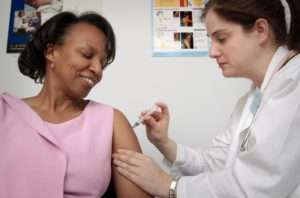
In the postvaccination antibody analysis, pairwise comparisons of the quantity of anti-spike IgG and anti-RBD IgG were made among participants, by vaccine product received, using the Wilcoxon rank-sum test. Analyses were conducted using R statistical software (version 4.0.3; R Foundation) and STATA (version 16; StataCorp). Procedures were approved as public health surveillance by each participating site and CDC†† and were conducted consistent with applicable federal law and CDC policy.§§
After excluding 1,786 patients from the VE analysis (936 for having an immunocompromising condition,¶¶ 566 who received ≥1 vaccine dose but were not fully vaccinated, and 284 who did not meet other eligibility criteria), 3,689 patients were included (1,682 case-patients and 2,007 control-patients). Overall, 2,362 (64.0%) patients were unvaccinated; 476 (12.9%) were fully vaccinated with the Moderna vaccine; 738 (20.0%) were fully vaccinated with the Pfizer-BioNTech vaccine, and 113 (3.1%) were fully vaccinated with the Janssen vaccine. Among all participants, the median age was 58 years, 48% were female, 23% were non-Hispanic Black, and 18% were Hispanic (Table 1). VE against COVID-19 hospitalization during March 11–August 15, 2021, was higher for the Moderna vaccine (VE = 93%) than for the Pfizer-BioNTech vaccine (VE = 88%) (p = 0.011); VE for both mRNA vaccines was higher than that for the Janssen vaccine (VE = 71%) (all p<0.001) (Table 2). VE for the Moderna vaccine was 93% at 14–120 days (median = 66 days) after receipt of the second vaccine dose and 92% at >120 days (median = 141 days) (p = 1.000). VE for the Pfizer-BioNTech vaccine was 91% at 14–120 days (median = 69 days) after receipt of the second vaccine dose but declined significantly to 77% at >120 days (median = 143 days) (p<0.001).
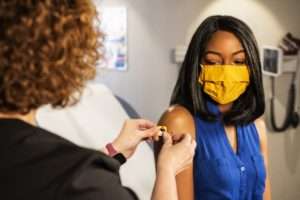
The postvaccination antibody analysis included 100 healthy volunteers, 32 fully vaccinated with Moderna (median age = 31 years; median interval from second vaccine dose to blood draw = 28 days), 51 fully vaccinated with Pfizer-BioNTech (median age = 27 years; median interval from second dose to blood draw = 27 days), and 17 fully vaccinated with Janssen (median age = 31 years; median interval from vaccine dose to blood draw = 35 days). Anti-RBD levels were higher in participants vaccinated with the Moderna vaccine (median = 4,333; interquartile range [IQR] = 3,134–7,197; geometric mean = 4,274; 95% CI = 3,393–5,384 BAU/mL) than in those who received the Pfizer-BioNTech vaccine (median = 3,217; IQR = 2,048–4,668; geometric mean = 2,950; 95% CI = 2,325–3,742 BAU/mL) (p = 0.033) or the Janssen vaccine (median = 57; IQR = 26–94; geometric mean = 51; 95% CI = 30–90 BAU/mL) (p<0.001) (Figure). Anti-spike IgG levels in participants vaccinated with the Moderna vaccine (median = 3,236; IQR = 2,125–4,975, geometric mean = 3,059; 95% CI = 2,479–3,774 BAU/mL) did not significantly differ from those in recipients of the Pfizer-BioNTech vaccine (median = 2,983; IQR = 1,954–4,059; geometric mean = 2,444; 95% CI = 1,936–3,085 BAU/mL) (p = 0.217), but were significantly higher than levels in participants who received the Janssen vaccine (median = 59; IQR = 30–104; geometric mean = 56; 95% CI = 32–97 BAU/mL) (p<0.001).
Jay Harold hopes you enjoyed this post, “COVID19 Vaccines Effectiveness: The Data” Please share it and read more about Jay Harold here. Please take this advice from Muhammad Ali and give it back to others. “Service to others is the rent you pay for your room here on earth.”
Bibliography

